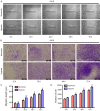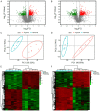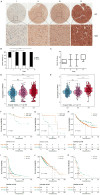P4HA1 as an unfavorable prognostic marker promotes cell migration and invasion of glioblastoma via inducing EMT process under hypoxia microenvironment
- PMID: 33575089
- PMCID: PMC7868758
P4HA1 as an unfavorable prognostic marker promotes cell migration and invasion of glioblastoma via inducing EMT process under hypoxia microenvironment
Abstract
This study aims to explore the mechanism of glioblastoma multiforme (GBM) in hypoxia through metabolomic and proteomic analysis. We showed that the migration and invasiveness of LN18 cells was significantly enhanced after 24 h of hypoxia treatment. The metabolomic and proteomic profiling were conducted in LN18 cells cultured under hypoxia condition. Correlation analysis between significant differential metabolites and proteins revealed seven proteins and ten metabolites, of which metabolite L-Arg was negatively correlated with P4HA1 protein. Meanwhile, the expression of HIF1α, nNOS and P4HA1 was up-regulated, and the concentration of L-Arg and NO was decreased and increased respectively. Knockdown of HIF1α reduced the expression of nNOS and P4HA1, the concentration of NO and the invasiveness of cells, while increased the concentration of L-Arg. Similar changes on P4HA1 expression, the concentration of L-Arg and NO were observed when the expression of nNOS was disrupted. Lastly, knockdown of P4HA1 impaired the invasion of LN18 and T98G cells, probably through regulating the expression of Vimentin, MMP2, MMP9, Snail and E-cadherin. Consistent trends on both the overexpression of these relevant genes, as well as the concentration of L-Arg and NO were also observed in all our overexpression experiments. Besides, we investigated the relationship between P4HA1 expression and prognosis by MTA, CGGA and TCGA databases. Increased P4HA1 level was correlated poor prognosis with advanced histological grade. In summary, we found that hypoxia promotes the migration and invasion of GBM via the L-Arg/P4HA1 axis which maybe an effective molecular marker or predictor of clinical outcome in GBM patients.
Keywords: Hypoxia; P4HA1; glioblastoma multiforme; invasion; migration; prognosis.
AJCR Copyright © 2021.
Conflict of interest statement
None.
Figures









Similar articles
-
HIF1α/ATF3 partake in PGK1 K191/K192 succinylation by modulating P4HA1/succinate signaling in glioblastoma.Neuro Oncol. 2024 Aug 5;26(8):1405-1420. doi: 10.1093/neuonc/noae040. Neuro Oncol. 2024. PMID: 38441561 Free PMC article.
-
P4HA1 Down-Regulation Inhibits Glioma Invasiveness by Promoting M1 Microglia Polarization.Onco Targets Ther. 2021 Mar 8;14:1771-1782. doi: 10.2147/OTT.S299977. eCollection 2021. Onco Targets Ther. 2021. PMID: 33727827 Free PMC article.
-
P4HA1/HIF1α feedback loop drives the glycolytic and malignant phenotypes of pancreatic cancer.Biochem Biophys Res Commun. 2019 Aug 27;516(3):606-612. doi: 10.1016/j.bbrc.2019.06.096. Epub 2019 Jun 22. Biochem Biophys Res Commun. 2019. PMID: 31239153
-
Prolyl 4-hydroxylase subunit alpha 1 (P4HA1) is a biomarker of poor prognosis in primary melanomas, and its depletion inhibits melanoma cell invasion and disrupts tumor blood vessel walls.Mol Oncol. 2020 Apr;14(4):742-762. doi: 10.1002/1878-0261.12649. Epub 2020 Feb 28. Mol Oncol. 2020. PMID: 32053263 Free PMC article.
-
P4HA1: an important target for treating fibrosis related diseases and cancer.Front Pharmacol. 2024 Nov 6;15:1493420. doi: 10.3389/fphar.2024.1493420. eCollection 2024. Front Pharmacol. 2024. PMID: 39568592 Free PMC article. Review.
Cited by
-
Preclinical and Clinical Applications of Metabolomics and Proteomics in Glioblastoma Research.Int J Mol Sci. 2022 Dec 25;24(1):348. doi: 10.3390/ijms24010348. Int J Mol Sci. 2022. PMID: 36613792 Free PMC article. Review.
-
Constructe a novel 5 hypoxia genes signature for cervical cancer.Cancer Cell Int. 2021 Jul 3;21(1):345. doi: 10.1186/s12935-021-02050-3. Cancer Cell Int. 2021. PMID: 34217310 Free PMC article.
-
Prognostic Value of Lymph Node Necrosis at Different N Stages in Patients with Nasopharyngeal Carcinoma.J Cancer. 2023 Jul 9;14(11):2085-2092. doi: 10.7150/jca.84854. eCollection 2023. J Cancer. 2023. PMID: 37497418 Free PMC article.
-
Proteotranscriptomic Discrimination of Tumor and Normal Tissues in Renal Cell Carcinoma.Int J Mol Sci. 2023 Feb 24;24(5):4488. doi: 10.3390/ijms24054488. Int J Mol Sci. 2023. PMID: 36901940 Free PMC article.
-
The exploration of mitochondrial-related features helps to reveal the prognosis and immunotherapy methods of colorectal cancer.Cancer Rep (Hoboken). 2024 Jan;7(1):e1914. doi: 10.1002/cnr2.1914. Epub 2023 Oct 30. Cancer Rep (Hoboken). 2024. PMID: 37903487 Free PMC article.
References
-
- Wright CH, Wright J, Onyewadume L, Raghavan A, Lapite I, Casco-Zuleta A, Lagman C, Sajatovic M, Hodges TR. Diagnosis, treatment, and survival in spinal dissemination of primary intracranial glioblastoma: systematic literature review. J Neurosurg Spine. 2019:1–10. - PubMed
-
- Field KM, Jordan JT, Wen PY, Rosenthal MA, Reardon DA. Bevacizumab and glioblastoma: scientific review, newly reported updates, and ongoing controversies. Cancer. 2015;121:997–1007. - PubMed
-
- Ramezani S, Vousooghi N, Joghataei MT, Chabok SY. The role of kinase signaling in resistance to bevacizumab therapy for glioblastoma multiforme. Cancer Biother Radiopharm. 2019;34:345–354. - PubMed
LinkOut - more resources
Full Text Sources
Research Materials
Miscellaneous
